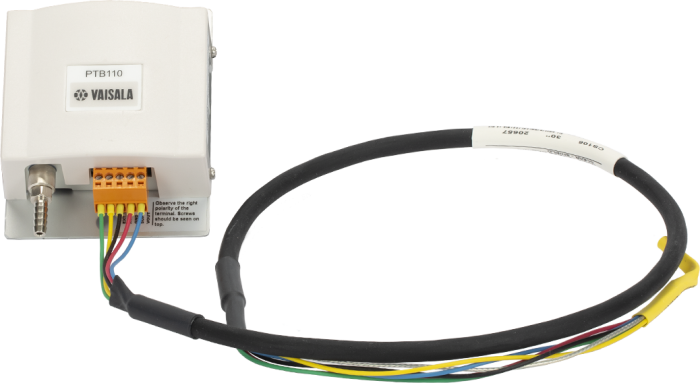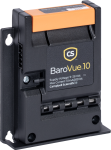
Resides inside weatherproof enclosure






Overview
The CS106, manufactured by Vaisala, measures barometric pressure for the range of 500 to 1100 mb. This range equates to from below sea level (as in a mine) to over 15,000 feet above sea level. Designed for use in environmental applications, the CS106 is compatible with all Campbell Scientific dataloggers.
Read MoreBenefits and Features
- Optimized to mount in Campbell Scientific enclosures
- Integral switching circuit limits power consumption to measurement cycle
- Three-year warranty
Technical Description
The CS106 uses Vaisala’s BAROCAP silicon capacitive sensor to measure barometric pressure. It is encased in a plastic shell (ABS/PC blend) fitted with an intake valve for pressure equilibration.
The CS106 outputs a linear signal of 0 to 2.5 Vdc, which allows the barometer to be directly connected to a Campbell Scientific datalogger. An internal switching circuit allows the datalogger to power the CS106 only during measurement, which reduces power consumption.
Images



Related Products
Compatibility
Please note: The following shows notable compatibility information. It is not a comprehensive list of all compatible products.
Dataloggers
| Product | Compatible | Note |
|---|---|---|
| CR1000 (retired) | ||
| CR300 (retired) | ||
| CR3000 | ||
| CR310 | ||
| CR350 | ||
| CR6 | ||
| CR800 (retired) | ||
| CR850 (retired) |
Additional Compatibility Information
Data Logger Considerations
A 2.5-ft cable is supplied with the sensor for connection to the data logger. The cable connects to a control port, single-ended analog input terminal, 12 V power terminal, and ground terminal on the data logger.
Mounting
The CS106 is typically mounted next to the data logger inside an ENC12/14 or larger enclosure. The very small ENC100 is available for housing the CS106 separately, in its own enclosure.
Specifications
| -NOTE- | 1 hPa = 1 mBar |
| Pressure Range | 500 to 1100 hPa |
| Long-Term Stability | ± 0.1 hPa per year |
| Settling Time | 1 s to reach full accuracy after power-up |
| Response Time | 500 ms to reach full accuracy after a pressure step |
| Output Voltage | 0 to 2.5 Vdc |
| Supply Voltage | 10 to 30 Vdc |
| Elevation | ~609.6 m (2,000 ft) below sea level (as in a mine) to 4,572 m (15,000 ft) above sea level |
| Accuracy |
|
| Linearity | ±0.25 hPa |
| Hysteresis | ±0.03 hPa |
| Repeatability | ±0.03 hPa |
| Calibration Uncertainty | ±0.15 hPa |
| Current Consumption |
|
| Temperature Range | -40° to +60°C |
| Dimensions | 6.8 x 9.7 x 2.8 cm (2.7 x 3.8 x 1.1 in.) |
| Cable Length | 76.2 cm (30 in.) |
| Weight | 90 g (3.2 oz) |
Resources and Links
Product Brochures
Manuals
Listed Under
FAQs for
Number of FAQs related to CS106: 12
Expand AllCollapse All
-
The CS106 is not a direct replacement. To use a CS106 in a system that previously used a CS105, the multiplier and offset will need to be changed in the program. Because the CS106 has a longer warm-up time, if the sensor is turned on and off, it may be necessary to make some adjustments to the warm-up time.
-
In most cases, enclosures and buildings have enough little spaces for the pressure to stay at equilibrium with the outside pressure. Therefore, the sensor does not need to be vented to the outside. It is possible, however, that the rate at which the pressure equalizes is slowed by being in an enclosure, but the rate change usually is not noticeably significant.
If the sensor resides in an absolutely air-tight environment, and the pressure outside this environment needs to be measured, then the sensor will need to be vented to the outside. However, venting to the outside may change the rating of the enclosure or associated inside environment.
-
Either the CS100 or the CS106 can fit inside an ENC100. For more information, refer to the Specifications information on the ENC100 product page.
-
The manufacturer recommends calibration on a yearly basis. However, conformance to published standards or regulations may require this on a more frequent basis.
-
The sensor plug on the CS106 is the same as the one on the CS105. If the cable and connections are still working correctly, it should be possible to power down the station and swap out the sensors without any difficulty.
-
For a reading in millibars, the multiplier is 0.240, and the offset is 500. To convert the millibar reading to different units, add an equation to the code.
To correct the pressure to sea level, see the “Correcting Pressure to Sea Level” section in the CS100 instruction manual or in the CS106 instruction manual. Alternatively, use Short Cut for Windows to generate the program, and, when prompted, enter the appropriate site elevation.
-
Yes, but only if certain conditions are met:
- The sensor resides in a non-condensing environment.
- The vent tube accessing the high humidity environment is extremely well desiccated to keep any moisture from reaching the sensor’s components. Moisture in the sensor will damage the sensor, often to an un-repairable state.
-
Noisy measurements may be caused by several factors:
- The sensor was not allowed to warm up adequately.
- The sensor is placed in an electrically noisy environment, which makes other analog measurements noisy.
- The power supply for the sensor or station is dirty. (There is not a clean regulated voltage.)
-
Generally, these sensors are designed to measure the pressure of the environment where they are installed. The CS100 or CS106 can measure the air pressure within a snowpack if the enclosure is adequately sealed away from the snow while allowing the vent to have access to the snow. Note that it may be difficult to accomplish this.
Case Studies
Southwestern South Africa had three consecutive dry winters—from 2015 through 2017—resulting in the Cape Town......read more
Currently, the Andean tropical glaciers are in an accelerated process of retreat. These glaciers are......read more
The past few years have seen a scramble within the power industry to use more......read more
In a country as large as Argentina, monitoring growing conditions in different agricultural regions is......read more
Articles and Press Releases
Privacy Policy Update
We've updated our privacy policy. Learn More
Cookie Consent
Update your cookie preferences. Update Cookie Preferences





